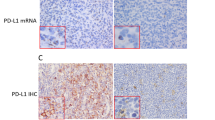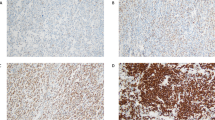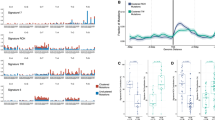Abstract
Among mechanisms potentially involved in resistance to alkylating agents and anthracyclines, the glutathione system has been extensively studied in vitro. We analyzed by immunohistochemistry the relation between glutathione s-transferase π (GST-π) expression in tumor cells and outcome in 69 cases of diffuse large B-cell NHL (DLBCL). GST-π expression was considered as low when <50% of tumor cells were stained and high when ⩾50% tumor cells were stained. Median follow-up was 58 months. GST-π expression was correlated with the probability of achieving complete remission (CR). Patients with high GST-π expression had a worse 5-year freedom from progression (FFP). High GST-π expression was associated with a trend for lower survival. In the group of patients with International Prognostic Index (IPI) 0–1, low GST-π expression was associated with a CR rate of 88%, a 5-year FFP of 76±20% and a 5-year survival of 78±16% compared to 36, 14±16 and 40±32%, respectively, in patients with a high GST-π expression (P=0.002, P<10−5 and P=0.01, respectively). No correlation was found between GST-π expression and lactico deshydrogenase serum level, age, Ann Arbor stage, performance status, and IPI index. Both GST-π expression and the IPI index correlated with FFP. After incorporating IPI and GST-π expression in a multivariate analysis for FFP, GST-p expression remained the only prognostic factor (P=0.003). Our findings suggest that GST-π expression had strong prognostic significance in DLBCL, which appears to be independent of other prognostic parameters in those disorders.
This is a preview of subscription content, access via your institution
Access options
Subscribe to this journal
Receive 12 print issues and online access
$259.00 per year
only $21.58 per issue
Buy this article
- Purchase on Springer Link
- Instant access to full article PDF
Prices may be subject to local taxes which are calculated during checkout





Similar content being viewed by others
References
Harris NL, Jaffe ES, Stein H, Banks PM, Chan JK, Cleary ML et al. A revised European–American classification of lymphoid neoplasms: a proposal from the International Lymphoma Study Group. Blood 1994; 84: 1361–1392.
The Non-Hodgkin's Lymphoma Classification Project. A clinical evaluation of the International Lymphoma study Group classification of non-Hodgkin's lymphoma by the non-Hodgkin's Lymphoma Classification Project. Blood 1997; 89: 3909–3918.
Fisher RI, Gaynor ER, Dahlberg S, Oken MM, Grogan TM, Mize EM et al. Comparison of a standard regimen (CHOP) with three intensive chemotherapy regimens for advanced non-Hodgkin's lymphoma. N Engl J Med 1993; 328: 1002–1006.
Haioun C, Lepage E, Gisselbrecht C, Salles G, Coiffier B, Brice P et al. Survival benefit of high-dose therapy in poor-risk aggressive non-Hodgkin's lymphoma: final analysis of the prospective LNH-87 protocol. A Groupe d'Etude des Lymphomes de l'Adulte study. J Clin Oncol 2000; 18: 3025–3030.
Tilly H, Mounier N, Lederlin P, Brière J, Dupriez B, Sebban C et al. Randomized comparison of ACVBP ad m-BACOD in the treatment of patients with low-risk aggressive lymphoma: the LNH 87-1 study. J Clin Oncol 2000; 18: 1309–1315.
The International non-Hodgkin's Lymphoma Prognostic Factor Project. A predictive model for aggressive non-Hodgkin's lymphoma. N Engl J Med 1993; 329: 987–994.
Hermine O, Haioun C, Lepage E, D'agay MF, Brière J, Lavignac C et al. Prognostic significance of bcl-2 protein in aggressive non-Hodgkin's lymphoma. Groupe d'Etude des Lymphomes de l'Adulte. Blood 1996; 87: 265–272.
Wilson WH, Teruya-Feldstein J, Fest T, Harris C, Steinberg SM, Jaffe ES et al. Relationship of p53, bcl-2, and tumor proliferation to clinical drug resistance in non-Hodgkin's lymphoma. Blood 1997; 89: 601–609.
Ichkawa A, Kinoshita T, Watanabe T, Kato H, Nagai H, Tsushita K et al. Mutations of the p53 gene as a prognostic factor in aggressive B-cell lymphoma. N Engl J Med 1997; 337: 529–534.
Moller MB, Gerdes AM, Skjodt K, Mortensen LS, Pedersen NT . Disrupted p53 function as predictor of treatment failure and poor prognosis in B- and T-cell non-Hodgkin's lymphoma. Clin Cancer Res 1999; 5: 1085–1091.
Drénou B, Lamy T, Amiot L, Fardel O, Colet-Maugendre S, Saportes M et al. CD3-CD56+ non-Hodgkin's lymphomas with an aggressive behavior related to multidrug resistance. Blood 1997; 8: 2966–2974.
Kang Y-K, Zhan Z, Regis J, Alvarez M, Robey R, Meadows B et al. Expression of mdr-1 in refractory lymphoma: quantitation by polymerase chain reaction and validation of the assay. Blood 1995; 86: 1515–1524.
Finnegan MCM, Royds J, Goepel JR, Lorigan P, Hancock W, Goyns MH . MDR-1 expression in non-Hodgkin's lymphomas is unrelated to treatment intensity or response to therapy. Leukemia Lymphoma 1995; 18: 297–302.
Filipits M, Jaeger U, Simonitsch I, Chizzali-Bonfadin C, Heinzl H, Pirker R . Clinical relevance of the lung resistance protein in diffuse large B-cell lymphomas. Clin Cancer Res 2000; 6: 3417–3423.
Zhan Z, Sandor VA, Gamelin E, Regis J, Dickstein B, Wilson W et al. Expression of the multidrug resisance-associated protein gene in refractory lymphoma: quantitation by a validated polymerase chain reaction assay. Blood 1997; 89: 3795–3800.
Yuen AR, Sikic BI . Multidrug resistance in lymphomas. J Clin Oncol 1994; 12: 2453–2459.
Kaczorowski S, Porwit A, Christensson B . Expression of P-glycoprotein in non-Hodgkin's lymphomas. Leukemia Lymphoma 1991; 5: 379–386.
Niehans GA, Jaszcz W, Brunetto V, Perri RT, Gajl-Peczalska K, Wick MR et al. Immunohistochemical identification of P-glycoprotein in previously untreated, diffuse large cell and immunoblastic lymphomas. Cancer Res 1992; 52: 3768–3775.
Miller TP, Grogan TM, Dalton WS, Spier CM, Sheper RJ, Salmon SE . P-glycoprotein expression in malignant lymphoma and reversal of clinical drug resistance with chemotherapy plus high-dose verapamil. J Clin Oncol 1991; 9: 17–24.
Tew KD . Glutathione-associated enzymes in anticancer drug resistance. Cancer Res 1994; 54: 4313–4320.
Cowan KH, Batist G, Tulpule A, etSinha BK, Myers CE . Similar biochemical changes associated with multidrug resistance in human breast cancer cells and carcinogen-induced resistance to xenobiotics in rats. Proc Natl Acad Sci USA 1986; 83: 928–932.
Robson CN, Lewis AD, Wolf CR, Hayes JD, Hall A, Proctor SJ et al. Reduced levels of drug-induced DNA cross-linking in nitrogen mustard-resistant Chinese hamster ovary cells expressing elevated glutathione-S-transferase activity. Cancer Res 1987; 47: 6022–6027.
Teicher BA, Holden SA, Kelley MJ, Shea TC, Cucchi CA, Rosowsky A et al. Characterisation of a human squamous carcinoma cell line resistant to cis-diamminedichloroplatinum (II). Cancer Res 1987; 47: 388–393.
McGown AT, Fox BW . A proposed mechanism of resistance to cyclophosphamide and phosphoramide mustard in a Yoshida cell line in vitro. Cancer Chemother Pharmacol 1986; 17: 223–226.
Sschisselbauer JC, Silber R, Papadopoulos E, Abrams K, LaCreta FP, Tew KD . Characterisation of glutathion-S-transferase expression in lymphocytes from chronic lymphocytic leukemia patients. Cancer Res 1990; 50: 3562–3568.
Ciaccio PJ, Tew KD, LaCreta FP . Enzymatic conjugation of cholrambucil with glutathione is catalyzed by human glutathione-S-transferase and inhibition by etacrynic acid. Biochem Pharmacol 1991; 42: 1504–1507.
Dirven HA, Dictus EL, Broeders NL, Van Ommen B, Van Bladeren PJ . The role of human glutathione S-transferase isoenzymes in the formation of glutathione conjugates of the alkylating drug thiotepa. Cancer Res 1995; 55: 1701–1706.
Ban N, Takahashi Y, Takayama T, Kura T, Katahira T, Sakamaki S et al. Transfection of glutathione S-transferase (GST) p antisense complementary DNA increases the sensitivity of a colon cancer cell line to adriamycin, cisplatin, melphalan and etoposide. Cancer Res 1996; 56: 3577–3582.
Shiga H, Heath EI, Rasmussen AA, Trock B, Johnston PG, Forastiere AA . Prognostic value of p53, glutathione s-transferase-π, and thymidylate synthase for neoadjuvant cisplatine-based chemotherapy in head and neck cancer. Clin Cancer Res 1999; 5: 4097–4104.
Bai F, Nakanishi Y, Kawasaki M, Takayama K, Yatsunami J, Pei XH et al. Immunohistochemical expression of glutathione S-transferase-pi can predict chemotherapy response in patients with non small cell lung carcinoma. Cancer (Phila.) 1996; 52: 967–977.
Tidefelt U, Elmhorn-Rosenborg A, Paul C, Hao XY, Mannervik B, Eriksson LC . Expression of glutathione transferase π as a predictor for treatment results at different stage of acute nonlymphoblastic leukemia. Cancer Res 1992; 52: 3281–3285.
Coiffier B, Gisselbrecht C, Herbrecht R, Tilly H, Bosly A, Brousse N . LNH-84 regimen: a multicenter study of intensive chemotherapy in 737 patients with aggressive malignant lymphoma. J Clin Oncol 1989; 7: 1018–1026.
Adida C, Haioun C, Gaulard P, Lepage E, Morel P, Brière J et al. Prognostic significance of survivin expression in diffuse large B-cell lymphoma. Blood 2000; 96: 1921–1925.
Yin Z, Ivanov VN, Habelhah H, Habelhah H, Tew KD, Ronai Z . Glutahione S-transferase p elicits protection against H2O2-induced cell death via coordinated regulation of stress kinases. Cancer Res 2000; 60: 4053–4057.
Wang T, Arifoglu P, Ronai Z, Tew KD . Glutathione S-transferase P1-1 inhibits c-Jun N-terminal kinase signaling through interaction with the C terminus. J Biol Chem 2001; 276: 20999–21003.
Tang G, Minemoto Y, Dibling B, Purcell NH, Li Z, Karin M et al. Inhibition of JNK through NF-κB target genes. Nature 2001; 414: 313–317.
Rosenwald A, Wright G, Chan WC, Connors JM, Campo E, Fisher RI et al. The use of molecular profiling to predict survival after chemotherapy for diffuse large B-cell lymphoma. N Engl J Med 2002; 346: 1937–1947.
Author information
Authors and Affiliations
Rights and permissions
About this article
Cite this article
Ribrag, V., Koscielny, S., Carpiuc, I. et al. Prognostic value of GST-π expression in diffuse large B-cell lymphomas. Leukemia 17, 972–977 (2003). https://doi.org/10.1038/sj.leu.2402930
Received:
Accepted:
Published:
Issue Date:
DOI: https://doi.org/10.1038/sj.leu.2402930
Keywords
This article is cited by
-
Cytotoxicity, antioxidant and glutathione S-transferase inhibitory activity of palladium(II) chloride complexes bearing nucleobase ligands
Transition Metal Chemistry (2014)
-
Expression of placental glutathione S-transferase in rat tongue mucosa exposed to cigarette smoke
Journal of Molecular Histology (2008)
-
Correlation between promoter hypermethylation of GSTP1 and response to chemotherapy in diffuse large B cell lymphoma
Annals of Hematology (2007)



